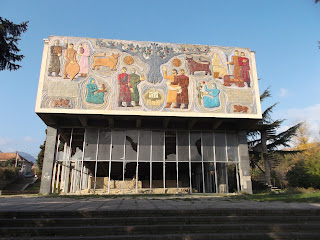Mtskheta used to be the capital of Georgia,
and it’s only about a twenty minute ride outside of Tbilisi. On an interesting side note, the name Tbilisi
comes from the Georgian word for “warm” because of the hot sulphur baths in the
city.
The marshrutka let us out in front of this
museum or whatever it was. Lovely
mosaics and bas relief sculptures. Not
so lovely smell. Apparently, it’s been
used as an open-air public toilet for a while.
Down the street a bit, we found a touristy
spot that looked a lot like the Germany section of Busch Gardens. We made our way down to the river, where the
Aragvi and the Kura Rivers meet. I
couldn’t get a decent picture of it, but this shot from a tourist website shows
it pretty well.
On our way up to the ruins of the old
castle, we passed an actual, bona-fide jogger on the road. This was such a strange occurrence that we
couldn’t help but stare at him as he passed.
People in Georgia don’t go jogging.
Ever. Must have been an American.
We also passed this sign, which was about
as strange as the jogger. Naturally, the
sign asking people not to litter and to keep Georgia clean was surrounded by
trash. Go figure.
The ruins had warnings about land slips,
but we like to live dangerously. The
view from the top was lovely. Off in the
distance, we could see the Jvari Monastery.
The biggest building in Mstkheta by far is
the Svetitskhoveli Cathedral where the Robe of Christ is said to be buried with
Saint Nino. Inside, it was much lighter
than most of the churches I’ve seen in Georgia as well as quite a lot
bigger. The walls are almost completely
covered in frescoes, and most of the former rulers of Georgia are buried
somewhere beneath the floor. There was a
Eucharist service going on while we were there, and we were able to hide in the
back and listen to the choir singing their amazing Georgian a capella
polyphony.
As we were eating the requisite khatchapuri
and lobiani outside a café (being eyed by some very hopeful lstray dogs), we
watched people being given rides in a horse-drawn carriage. Kelsey says that Mtskheta reminds her of
Mackinaw Island in Michigan. There are
hardly any cars, everything is very close to everything else, and the whole
place has an air of being somehow removed from the rest of Georgia. I’ve never been to Mackinaw Island, but it
sounds like a pretty nice place.
Kelsey had to head back to Apeni when we
got back to Tbilisi, but I was going to Ani’s dance recital that
afternoon. She does traditional Georgian
dancing, and her troupe was performing with a bunch of other schools from
around the country. I got lost trying to
find the theatre, so I was late (as usual).
When I finally found the theatre, I
couldn’t actually find the audience and the stage. I wandered around backstage, passing dozens
of little girls and boys in dancing costumes with lots of makeup. It was exactly like my ballet recitals when I
was a kid, except with more bangles and less tulle. At one point, I almost walked out on the
stage itself.
Dancers were there representing each region
of Georgia, each with its own distinct style of music and costume. Some of them whirled around the stage like
dervishes in bright skirts; some of them glided slowly and smoothly across the
stage in long, formal gowns. There were,
of course, lots of tiny boys in giant, fluffy hats. Forget running with scissors; these kids were
dancing with knives. And flying.
 |
| I think one of these girls is Ani |
When all was done and Ani was on her bus
back to Telavi, I went back to the hostel to wait for my train to Zugdidi at
midnight. While waiting for midnight, I
tried to explain to the Italian guy there who doesn’t speak English or Georgian
that I really can’t explain the conflict in Northern Ireland with
pantomime. It was a strange evening.







No comments:
Post a Comment